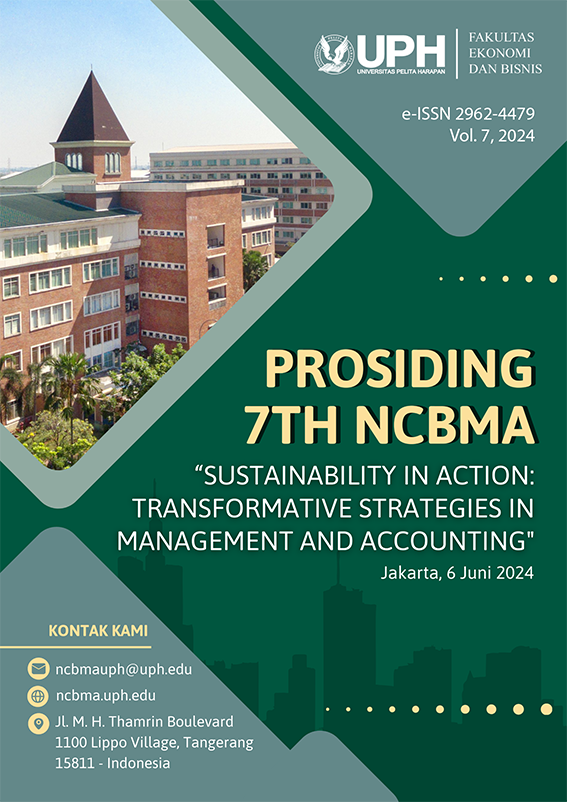THE INFLUENCE OF INTEREST PAYMENT ABILITY TO RELATION BETWEEN COMPANY RISK AND DEBT LEVEL
Keywords:
Trade off, debt level, business risk, interest paymentAbstract
Trade off theory suggests that as business risk increases (decreases), company debt level will decrease (increase). This is because companies compensate for higher business risk with lower debt level as debt is riskier than equity. Companies also avoid higher interest rate charged for debt to companies with higher business risk. We found that company’s ability to pay for interest expense mitigate the negative relation between business risk and debt level among manufacture companies in Indonesia. As the ability to pay interest expenses increases, bankruptcy risk decreases. Lenders will perceive the company as a low-risk company, even though business risk is high. Another mechanism is that the ability to pay interest acts as a signal that the company has lower risk than what business risk suggests. The result is lower interest rate that leads to higher debt level.
References
Akhmadi, A., Yunia, D., & Robiyanto, R. (2020). The role of profitability in the effect of company growth on the debt policy. International Journal of Financial Research, 11(4), 267-274.
Ahn, Y. (2019). Distress cost and corporate financing policy: evidence from the equity options market. Applied Economics, 51(39), 4299-4312. https://doi.org/10.1080/00036846.2019.1591604
Albart, N., Sinaga, B. M., Santosa, P. W., & Andati, T. (2020). The effect of corporate characteristics on capital structure in Indonesia. Journal of Economics, Business, and Accountancy Ventura, 23(1), 68-78. https://doi.org/10.14414/jebav.v23i1.2153
Alnajjar, M. I. (2015). Business risk impact on capital structure: A case of jordan industrial sector. Global Journal of Management and Business Research: C Finance, 15(1), 1-7.
Eleftheriadis, I. M. (2018). Corporate trade-off hypothesis: An investigation of relationship between business and financial risk. Corporate Ownership & Control, 15(2-1), 258-263. http://doi.org/10.22495/cocv15i2c1p11
Fitrianti, R., Farhan, A., Rahayu, S., Radiany, M. A., & Julikah, J. (2021). Effect of profitability of the company in the debt policy (Case studies on LQ45 companies listed on the IDX in 2016-2017). Jurnal Ilmiah Manajemen Kesatuan, 11(10).
Gordon, R. H., & Lee, Y. (2001). Do taxes affect corporate debt policy? Evidence from US corporate tax return data. Journal of Public Economics, 82(2), 195-224. https://doi.org/10.1016/S0047-2727(00)00133-X
Graham, J. R. (1996). Debt and the marginal tax rate. Journal of Financial Economics, 41(1), 41-73. https://doi.org/10.1016/0304-405X(95)00826-C
Harwood, E., & Manzon Jr, G. B. (2000). Tax clienteles and debt maturity. Journal of the American Taxation Association, 22(2), 22-39. https://doi.org/10.2308/jata.2000.22.2.22
Hidayat, C. M., Laksana, R. D., & Banani, A. (2019). Analysis of factors that influence the capital structure. International Conference on Rural Development and Entrepreneurship, 5(1), 823-832. http://jp.feb.unsoed.ac.id/index.php/Icore/article/view/1760/1690
Kale, J. R., Noe, T. H., & Ramirez, G. G. (1991). The effect of business risk on corporate capital structure: Theory and evidence. The Journal of Finance, 46(5), 1693-1715. https://doi.org/10.1111/j.1540-6261.1991.tb04639.x
Liu, W. C. (2017). Trade-off theory of capital structure: evidence from estimations of non-parametric and semi-parametric panel fixed effect models. Investment Management and Financial Innovations, 14(1), 115-123. http://dx.doi.org/10.21511/imfi.14(1).2017.11
Matemilola, B. T., & Ahmad, R. (2015). Debt financing and importance of fixed assets and goodwill assets as collateral: dynamic panel evidence. Journal of Business Economics and Management, 16(2), 407-421. https://doi.org/10.3846/16111699.2012.720598
Modigliani, F., & Miller, M. H. (1958). The cost of capital, corporation finance and the theory of investment. The American Economic Review, 48(3), 261-297.
Myers, S. C., & Majluf, N. S. (1984). Corporate financing and investment decisions when firms have information that investors do not have. Journal of Financial Economics, 13(2), 187-221. https://doi.org/10.1016/0304-405X(84)90023-0
Pascale, R. (2018). Firm size and debt: Evidence from the Uruguayan manufacturing sector using panel data. Available at SSRN: https://ssrn.com/abstract=3260943
Sofat, R., & Singh, S. (2017). Determinants of capital structure: an empirical study of manufacturing firms in India. International Journal of Law and Management, 59(6), 1029-1045. https://doi.org/10.1108/IJLMA-05-2016-0051
Downloads
Published
Issue
Section
License
Copyright (c) 2024 Angelica Octavia, Yanuar Dananjaya

This work is licensed under a Creative Commons Attribution-ShareAlike 4.0 International License.

